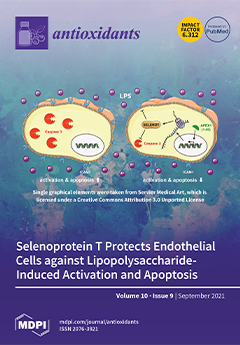The generation of peroxynitrite (ONOO
−) is associated with several diseases, including atherosclerosis, hypertension, neurodegeneration, cancer, inflammation, and sepsis. Alpha-ketoglutarate (αKG) is a known potential highly antioxidative agent for radical oxidative species such as peroxides. The question arises as to whether αKG
[...] Read more.
The generation of peroxynitrite (ONOO
−) is associated with several diseases, including atherosclerosis, hypertension, neurodegeneration, cancer, inflammation, and sepsis. Alpha-ketoglutarate (αKG) is a known potential highly antioxidative agent for radical oxidative species such as peroxides. The question arises as to whether αKG is also a potential scavenger of ONOO
− and a potential protector against ONOO
−-mediated nitration of proteins. NMR studies of 1 mM αKG in 100 mM phosphate-buffered saline at pH 7.4 and pH 6.0 were carried out in the presence or absence of a final concentration of 2 mM ONOO
−. An ONOO
−–luminol-induced chemiluminescence reaction was used to measure the scavenging function of several concentrations of αKG; quantification of αKG was performed via spectrophotometric enzymatic assay of αKG in the absence or presence of 0, 1, or 2 mM ONOO
−. The nitration of tyrosine residues on proteins was measured on ONOO
−-treated bovine serum albumin (BSA) in the presence or absence of 0–24 mM αKG by an ELISA technique using a specific anti-IgG against nitro-tyrosine. The addition of ONOO
− to αKG led to the formation of succinic acid and nitrite at pH 7.0, but not at pH 6.0, as αKG was stable against ONOO
−. The absorbance of enzymatically estimated αKG at the time point of 30 min was significantly lower in favour of ONOO
− (1 mM: 0.21 ± 0.03, 2 mM: 0.12 ± 0.05 vs. 0 mM: 0.32 ± 0.02;
p < 0.001). The luminol technique showed an inverse logarithmic correlation of the ONOO
− and αKG concentrations (
y = −2 × 10
5 ln(
x) + 1 × 10
6;
r2 = 0.99). The usage of 4 mM αKG showed a significant reduction by nearly half in the chemiluminescence signal (284,456 ± 29,293 cps,
p < 0.001) compared to the control (474,401 ± 18,259); for 20 and 200 mM αKG, there were further reductions to 163,546 ± 26,196 cps (
p < 0.001) and 12,658 ± 1928 cps (
p < 0.001). Nitrated tyrosine residues were estimated using the ELISA technique. A negative linear correlation was obtained by estimating nitrated tyrosine residues in the presence of αKG (
r2 = 0.94): a reduction by half of nitrated tyrosine was estimated using 12 mM αKG compared to the control (326.1 ± 39.6 nmol vs. 844.5 ± 128.4 nmol;
p < 0.001).
Full article






